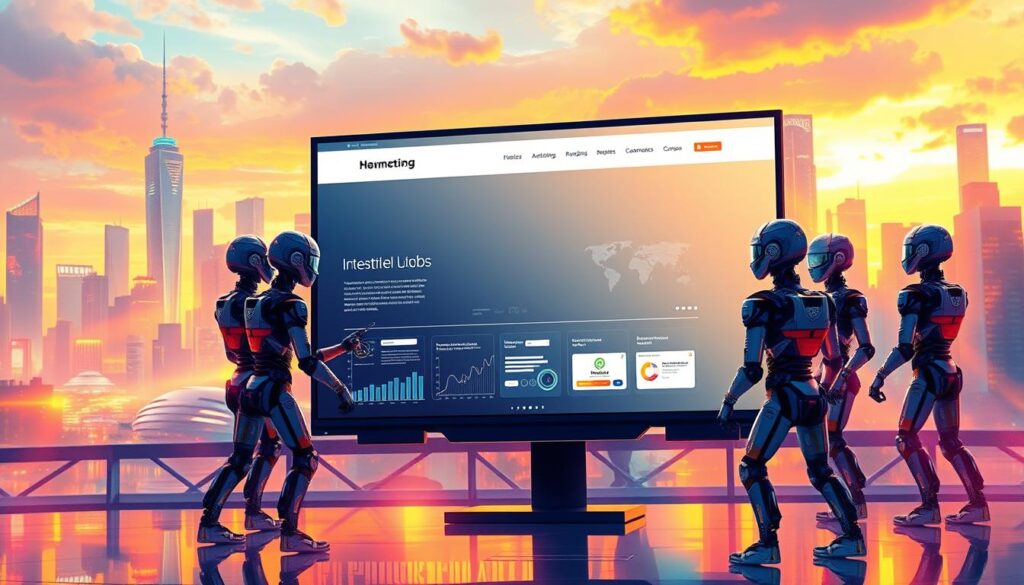In today’s digital world, having a strong online presence is key for businesses to thrive. The rise of AI and machines makes it vital for companies to adapt and use these technologies. This way, they can stay ahead in the game.
At Design Drill, we focus on building a solid online presence for businesses. We do this through custom website design and development. Our aim is to make it simple for businesses to get online without any trouble.
By embracing AI and machines, we help businesses excel online. This way, they can thrive in the digital age.
Key Takeaways
- Having a strong online presence is key for businesses to succeed.
- AI and machines are changing how businesses operate online.
- Custom website design and development are essential for a strong online presence.
- Businesses can use AI and machines to stay ahead of the competition.
- Design Drill specializes in helping businesses create a strong online presence.
The Digital Revolution: Why Every Business Needs an Online Presence Today
In today’s world, having an online presence is essential for businesses to succeed. The digital revolution has changed how people shop and buy things. Now, more people use the internet to find and buy products.
The Shifting Consumer Behavior in the Digital Age
How people interact with businesses has changed a lot. More people use digital platforms to talk to businesses. This is because online shopping is easy and accessible.
Statistics on Online Shopping and Research
Many people use their phones to shop online. A big part of online shopping happens on mobile devices. This shows how important it is for businesses to be mobile-friendly.
Mobile-First Consumer Journeys
Now, most people start their shopping journey on their phones. Businesses need to make sure their websites work well on mobile devices. This way, they can meet the needs of today’s shoppers.
The Cost of Being Invisible Online
Not having a strong online presence can hurt a business a lot. Being invisible online means missing out on sales and falling behind competitors.
Lost Revenue Opportunities
Without an online presence, businesses can’t reach new customers. People are looking online to find and buy products. So, it’s key for businesses to be seen online.
Competitive Disadvantages
Businesses that don’t keep up with the digital world will fall behind. In today’s online world, having a strong online presence is key to staying ahead.
Understanding the AI and Machine Learning Revolution
AI and machine learning are leading the tech world, changing how businesses work and talk to customers. As these techs grow, their role in business operations gets bigger.
What Exactly is AI and Machine Learning?
Artificial Intelligence (AI) is about making computers do things that humans do, like seeing, hearing, and making choices. Machine learning is a part of AI that lets machines get better at tasks by learning from data.
Key Technologies Powering Modern Websites
Modern websites rely on several key technologies, including:
- Natural Language Processing (NLP): Helps computers understand and get what humans say.
- Deep Learning: Uses special networks to dig into complex data.
- Predictive Analytics: Looks at past data to guess what will happen next.
How AI is Transforming Business Operations
AI is changing business operations in many ways, such as:
Automation of Routine Tasks
By automating simple tasks, businesses can save time and energy for more important things. For example, AI chatbots can answer customer questions, easing the load on human support teams.
Enhanced Decision Making
AI and machine learning can sift through huge amounts of data, giving businesses insights to guide their choices. This helps companies make smarter, data-backed decisions.
The Convergence of AI and Web Development
AI is making websites smarter and easier to use. AI tools can make websites more personal, help users find what they need, and make the site run better.
How AI and Machines can be Master itself Business need online presence Website
AI and machines are key in the digital world. They help businesses have a strong online presence. Tools like AI for website creation, machine learning for insights, and automated content are changing how businesses are online.
AI-Powered Website Creation Tools
AI is changing website creation with advanced tools. Design Automation Platforms and Code Generation Technologies are leading this change.
Design Automation Platforms
These platforms use AI to make designing websites easy. They analyze trends and user preferences to create custom designs.
Code Generation Technologies
These technologies turn design into code. This makes websites faster and cheaper to make.
Machine Learning for Customer Insights
Machine learning analyzes customer data for insights. It helps understand what customers like and do.
Behavior Analysis and Prediction
It predicts what customers might do next. This helps businesses plan their marketing better.
Automated Content Generation and Management
AI helps with content creation and management. AI Writing Assistants and Dynamic Content Optimization are two main uses.
AI Writing Assistants
These assistants improve content quality. They suggest ideas and even write drafts. This saves time and boosts content quality.
Dynamic Content Optimization
AI adjusts content based on user interactions. This keeps content engaging and relevant.
AI technologies help businesses create a strong online presence. They attract and keep customers. As AI grows, we’ll see more new solutions for the digital world.
Step1: Assessing Your Business’s Digital Needs
Starting a successful online presence begins with understanding your business’s digital needs. This first step is key to creating a strategy that meets your goals.
Identifying Your Online Goals and Objectives
To assess your digital needs, you must first know your online goals. This means figuring out what you aim to achieve online.
Brand Awareness vs. Direct Sales
Your goals might be to boost brand awareness or drive direct sales. Finding the right balance between these is important.
| Goal | Description | Example |
|---|---|---|
| Brand Awareness | Increasing visibility and recognition of your brand | Social media campaigns |
| Direct Sales | Driving sales directly through your website | E-commerce platforms |
Understanding Your Target Audience
Knowing your target audience is key to a successful online presence. This means creating detailed customer personas.
Creating Customer Personas
Customer personas are fictional yet based on real data. They help you understand your ideal customers.
Determining the Right Digital Platforms for Your Business
With clear goals and audience in mind, choose the right digital platforms for your business.
Website, Social Media, and Beyond
This might include a website, social media, or other channels. Each has its own role in reaching your online goals.
Step2: Planning Your Website Structure and Content
Now that we’ve looked at your business’s digital needs, it’s time to plan your website. A well-planned website is key for a good user experience and reaching your online goals.
Essential Pages Every Business Website Needs
Every business website needs certain essential pages. These include:
- Home: The main entry point of your website.
- About: Provides information about your business and its mission.
- Services: Details the services you offer.
- Contact: Makes it easy for visitors to get in touch with you.
Information Architecture for User-Friendly Navigation
A user-friendly navigation is key to keeping visitors engaged. This involves:
Wireframing Your Website
Creating a wireframe helps visualize your website’s layout and navigation.
Content Planning and SEO Strategy
A good content planning and SEO strategy are vital for search engine visibility.
Keyword Research and Implementation
Conducting thorough keyword research and implementing those keywords effectively in your content is key.
| Page Type | Purpose | SEO Considerations |
|---|---|---|
| Home | Main entry point | Target primary keywords |
| About | Business information | Use long-tail keywords |
| Services | Detail services offered | Optimize with relevant keywords |
| Contact | Facilitate communication | Include location keywords if relevant |
Step3: Choosing Between Custom Design and Templates

Choosing between custom web design and templates is key for businesses online. This choice affects how a brand looks online and its digital success.
The Benefits of Custom Web Design
Custom web design has big advantages, like creating a unique brand identity. A custom site can match a company’s brand perfectly, meeting its specific needs.
Unique Brand Identity and Positioning
A custom site helps businesses stand out online. This uniqueness boosts brand recognition and loyalty.
- Enhanced brand credibility
- Tailored user experience
- Better alignment with business goals
When Templates Make Sense
Templates are also good, mainly for small businesses or startups with tight budgets. They’re quicker and cheaper than custom designs.
Budget and Timeline Considerations
Templates are faster and cheaper. They’re great for businesses that need a quick site or have a small budget.
- Faster deployment
- Lower upfront costs
- Easier maintenance
Design Drill’s Custom Website Development Process
At Design Drill, we focus on custom websites for each business. Our goal is to create high-quality, functional, and attractive sites.
From Concept to Launch
Our process starts with a concept and ends with launch. We work with clients to ensure their site meets their needs and is ready on time.
Understanding custom design and templates helps businesses choose wisely. At Design Drill, we aim to help businesses thrive online.
Step4: Implementing AI-Powered Features for Enhanced User Experience
In today’s digital world, using AI is key to better user experiences on websites. AI helps improve how people use our online sites. It makes the experience more fun and tailored to each user.
AI-Powered Chatbots and Customer Service
Chatbots powered by AI are a big deal for customer service. They offer 24/7 customer support automation. This means customers get help anytime they need it.
24/7 Customer Support Automation
AI chatbots handle simple customer service tasks. This lets humans focus on harder problems. It makes customers happier and gets them help faster.
Personalization Through Machine Learning
Machine learning looks at what users like and do. It makes dynamic content based on user behavior. This makes the site more interesting and keeps users coming back.
Dynamic Content Based on User Behavior
Machine learning changes the site to match what users like. This makes users more engaged and likely to buy. It builds a strong bond with the audience.
Predictive Analytics for User Behavior
Predictive analytics guess what customers might want next. It uses past data and current trends. This helps businesses meet customer needs before they even ask.
Anticipating Customer Needs
Using predictive analytics, businesses can meet customer needs before they ask. This makes the site more intuitive and responsive. It keeps customers coming back and loyal.
| AI-Powered Feature | Description | Benefit |
|---|---|---|
| Chatbots | Automated customer support | 24/7 customer support |
| Personalization | Dynamic content based on user behavior | Improved engagement |
| Predictive Analytics | Anticipating customer needs | Proactive customer service |
Step5: E-commerce Integration and Optimization
The digital world changes fast, and e-commerce is no exception. For online sellers, making their e-commerce site better is key. It helps give customers a smooth shopping experience and boosts sales.
Essential E-commerce Features for Modern Businesses
Today’s e-commerce sites need some important features to stay ahead. These include:
- Intuitive product catalogs that make it easy for customers to find what they’re looking for
- Secure and efficient shopping carts that simplify the checkout process
- Mobile-responsive design to cater to the growing number of mobile shoppers
Product Catalogs and Shopping Carts
A good product catalog is essential for any e-commerce site. It should be easy to use, with clear categories and great product images. The shopping cart should also be simple, letting customers easily add or change items before they check out.
AI-Driven Product Recommendations
AI can make shopping better by suggesting products based on what customers have looked at or bought. This can help increase the average order value and make customers happier.
Cross-Selling and Upselling Opportunities
AI can also spot chances to sell more by suggesting related products or better versions of what customers want. This can lead to more sales and loyal customers.
Secure Payment Processing Solutions
Security is critical for e-commerce. Businesses must use secure payment options to protect customer data and gain trust.
Building Customer Trust Through Security
Using strong security like SSL certificates and two-factor authentication helps show customers their data is safe. This builds trust and can lower cart abandonment rates.
By focusing on these key areas of e-commerce, businesses can build a strong online presence. This attracts and keeps customers, helping the business grow and make more money.
Step6: Creating Responsive and Mobile-Friendly Designs
Most people now use mobile devices to surf the web. So, making your website mobile-friendly is key for a good user experience. It’s important to focus on mobile-friendliness to meet the needs of more users.
The Importance of Mobile Optimization
Mobile optimization is now a must, not just a choice. The world has quickly moved to mobile browsing. Businesses need to keep up to stay ahead.
Mobile Traffic Statistics and Trends
Mobile devices are now a big part of web traffic. This trend is likely to grow. So, making your website mobile-friendly is very important.
| Device Type | Percentage of Web Traffic |
|---|---|
| Mobile Devices | 55% |
| Desktop Computers | 40% |
| Tablets | 5% |
Responsive Design Principles
A responsive design makes your website look good and work well on all devices. It uses fluid grids and flexible images to achieve this.
Fluid Grids and Flexible Images
Fluid grids help your website’s layout adjust to different screen sizes. Flexible images make sure images are the right size. Together, they create a responsive design.
Testing Across Devices and Browsers
After designing your website to be responsive, test it on various devices and browsers. This ensures it works well everywhere and finds any problems.
Quality Assurance Processes
Our quality check involves detailed testing to make sure your website works well on all platforms. We look for layout problems, broken links, and check that everything works right.
By focusing on responsive design and testing, we make sure your website is easy to use for everyone. No matter how they access it.
Step7: Implementing Technical SEO and Performance Optimization
Search engine algorithms keep changing, making technical SEO and performance optimization key. It’s vital to know the technical sides that affect our site’s visibility and user experience.
Page Speed Optimization Techniques
Page speed is key for both user experience and search rankings. We can improve page speed with several methods:
- Image compression to reduce file sizes without losing quality.
- Code minification to make our website’s code more efficient.
- Leveraging browser caching to store resources locally.
Image Compression and Code Minification
Image compression makes images load faster. Tools like TinyPNG and ImageOptim can compress images well. Code minification removes unnecessary characters from our files, making them smaller and faster.
Technical SEO Best Practices
Technical SEO best practices help our website be crawlable and visible to search engines. Key practices include:
- Using schema markup to add context to our content.
- Optimizing our website’s structure and internal linking.
- Making sure our website is mobile-friendly and responsive.
Schema Markup and Structured Data
Schema markup helps search engines understand our content better. It makes our search engine listings more attractive with rich snippets. By using schema markup, we can boost our website’s visibility and click-through rates.
Mobile-First Indexing Preparation
Most searches now come from mobile devices, so preparing for mobile-first indexing is essential. This means:
- Ensuring our website is mobile-friendly and responsive.
- Optimizing our content for mobile users.
- Understanding Google’s ranking factors and their impact on mobile-first indexing.
Google’s Ranking Factors
Google considers page speed, mobile-friendliness, and content quality when ranking sites. By focusing on these factors, we can improve our site’s rankings and attract more visitors.
Step8: Setting Up Analytics and Tracking
To make smart decisions, businesses must set up analytics and tracking on their website. This step helps them see how their site is doing. It shows where they can get better and how to improve online.
Essential Metrics to Monitor
It’s important to watch the right numbers to know how your site is doing. Key numbers include:
- Traffic: Knowing how many people visit your site.
- Conversions: Seeing what actions visitors take on your site.
- Engagement: Figuring out how visitors interact with your content.
Traffic, Conversions, and Engagement
Looking at these numbers together gives a full picture of your site’s performance. For example, lots of visitors but few actions might mean you need to work on your calls to action or landing pages.
AI-Powered Analytics Tools
AI-powered analytics tools make understanding and using your website data better. They have cool features like predictive analytics and automated insights.
Predictive Analytics and Insights
Predictive analytics uses past data and AI to guess what will happen next. This lets businesses change their plans early to make their site better.
Using Data to Drive Website Improvements
The main goal of setting up analytics and tracking is to use the data to keep making your site better. By checking your numbers and insights often, you can find what needs work and make smart choices.
Continuous Optimization Strategies
Continuous optimization means always trying new things and making small changes based on data. This could be A/B testing, looking at user feedback, or making small design tweaks.
Step9: Launching and Marketing Your Website

Launching a website is a big step in making a strong online presence. It needs careful planning and execution. We must make sure everything is ready for a successful online launch.
Pre-Launch Checklist
Before we launch, we need to check everything off a pre-launch list. This includes:
- Reviewing content for accuracy and consistency
- Testing all interactive elements, such as forms and buttons
- Ensuring cross-browser compatibility
- Optimizing images and other media
Final Testing and Quality Assurance
Final testing is key to find and fix any bugs. This step makes sure our website is stable, secure, and works right.
Announcement Strategies
After our website goes live, we need to tell our audience. Good ways to do this include:
- Social media campaigns to create buzz around the launch
- Email marketing to notify subscribers and customers
- Press releases to reach a wider audience
Social Media and Email Campaigns
Social media and email campaigns are key to getting people to our website. By making engaging content and offers, we can draw in visitors and get them to explore our site.
Ongoing Marketing and Promotion
After the launch, we need to keep marketing to keep the excitement going. This includes:
| Marketing Strategy | Description | Benefits |
|---|---|---|
| Content Marketing | Creating valuable, relevant content to attract and retain a clearly defined audience. | Increased engagement, improved SEO |
| PPC Advertising | Using paid advertising to drive traffic to our website. | Targeted traffic, measurable ROI |
Content Marketing and PPC Advertising
By mixing content marketing and PPC advertising, we can make a strong marketing plan. This plan drives traffic, engagement, and conversions.
Step10: Maintaining and Updating Your Online Presence
Keeping your online presence up-to-date is a continuous effort. Businesses must always update and refine their online presence. This ensures a smooth user experience and keeps up with changing consumer habits.
Regular Content Updates
Updating your website’s content regularly is key. It keeps your audience interested and boosts your search engine rankings. Fresh content also makes your brand a trusted name in your field.
Blogging and Fresh Content Creation
Starting a blog and posting new content often can greatly improve your online presence. This can include sharing industry insights, company news, or helpful tips. It not only boosts your SEO but also adds value to your customers.
Security Patches and Technical Maintenance
Website security is a top priority. Regular updates and maintenance protect against cyber threats and data breaches.
Protecting Against Cyber Threats
Cyber threats are getting more complex. To protect your online presence, keep up with the latest security measures. This includes SSL certificates, firewalls, and malware detection tools.
Periodic Design Refreshes
A modern website design is essential for a good first impression. Regular design updates keep your site looking fresh and engaging. This improves user experience and keeps them coming back.
When and How to Update Your Look
Updating your website’s design should be done with care. Consider changes in your brand, industry trends, and user feedback. Aim to refresh your design every 2-3 years or as needed.
| Maintenance Task | Frequency | Importance |
|---|---|---|
| Content Updates | Weekly/Monthly | High |
| Security Patches | As Needed | Critical |
| Design Refreshes | Every 2-3 Years | Medium |
Real-World Success Stories: AI-Powered Business Websites
At Design Drill, we’ve seen how AI-powered websites change businesses. We’ve found that AI and machine learning boost online presence and results.
Small Business Transformation Case Studies
We’ve helped many small businesses improve online with AI. A local retail business, for example, saw 30% more online sales with our AI website.
Before and After Results
The retail business had trouble with website traffic and engagement at first. But with AI-powered features like personalized product recommendations and chatbots, they saw a big jump in sales and customer interaction.
Enterprise-Level AI Implementation Examples
We’ve also worked with big companies, implementing advanced AI solutions. For example, a top e-commerce site reduced 25% of customer service inquiries with our AI chatbot.
Scalability and Integration
Our AI solutions grow with your business and fit with your systems. This means any business can use our tech without hassle.
Design Drill Client Success Stories
Our clients have seen amazing results with our AI websites. One client got 50% more website engagement in just a month with our AI content tool.
Measurable Results and ROI
We keep track of our AI solutions’ performance. Our data shows an average 200% return on investment (ROI) in the first year for our clients.
Conclusion: Embracing the AI-Driven Future of Online Business
AI and machines are changing how businesses work and talk to customers. By embracing the ai-driven future, companies can stay ahead. Design Drill helps businesses use AI to make websites that work well.
The future of online business is linked to AI and machine learning. As these techs get better, businesses that use them will meet customer needs better. We’re excited to help businesses grow in the ai-driven future.
Businesses can grow and connect with customers more by using AI. Technology and business will keep shaping the online business world. We’re here to help businesses succeed in the digital world.


